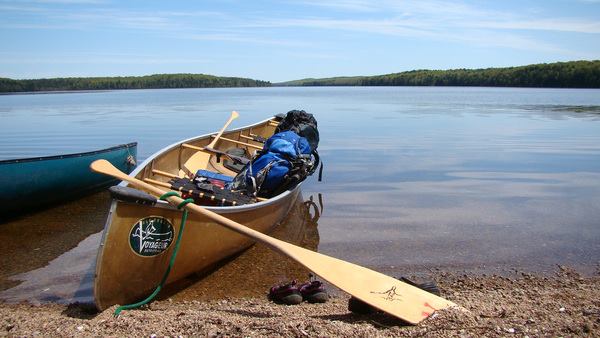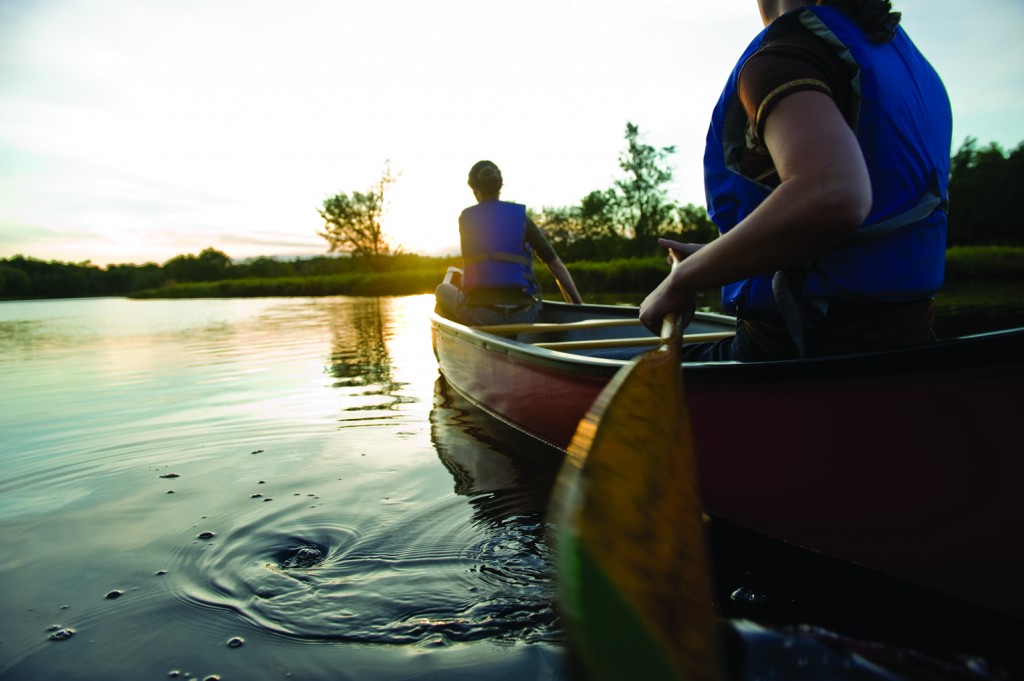On Feminizing Canoe-Tripping: Why We Chose the Name “Lily Paddlers”
This blog post was written by guest blogger Ledah McKellar.
We are four women in their early thirties who come from different places. We seek to escape the busyness of our lives for a short time to find a deeper connection to nature, each other and ourselves.
Over this past winter, I felt an emptiness in my heart that I could not quite place. I knew I missed a strong female presence in my life. Women who were bold enough to be vulnerable, courageous enough to cry, strong enough to support each other.
And so, here we are, the Lily Paddlers. About to embark on a seven-day journey through the Path of the Paddle section of Quetico Provincial Park. We are creating an intentional space to allow for deeper bonding with one another.
 Every year we go to paddling festivals and watch films that obsess about conquering that next portage or that next set of rapids. We watch films that elevate extreme sports and risk-taking and pushing yourself beyond your physical capacity. Success is measured by defeating your personal best record. Often, the adventurers are strapped for time and pressing hard to make it to their final destination. There is a busyness, perhaps masculinity, and as Jocelyn would put it, “consuming of experience,” linked to this type of relationship with nature and the desire to push through the impossible. It’s not a question of good or bad, but this approach certainly dominates the representation we see in popular culture.
Every year we go to paddling festivals and watch films that obsess about conquering that next portage or that next set of rapids. We watch films that elevate extreme sports and risk-taking and pushing yourself beyond your physical capacity. Success is measured by defeating your personal best record. Often, the adventurers are strapped for time and pressing hard to make it to their final destination. There is a busyness, perhaps masculinity, and as Jocelyn would put it, “consuming of experience,” linked to this type of relationship with nature and the desire to push through the impossible. It’s not a question of good or bad, but this approach certainly dominates the representation we see in popular culture.
We live in a time when many people are ruled by busyness and the clock. We struggle to balance 9-5 jobs, with exercise, eating well and perhaps kids. It’s a mad juggling game. “Busy” is the new response to “How are you,” and most of us are guilty at one point in time of competing to be more productive and busier than another.
This has become so ingrained in our lives that sometimes we apply this to our vacations as well. How many countries can we see on a trip to Southeast Asia? How many stamps can I get in my passport? How many portages can we do in a day? How many kilometres in a trip?
And yet while we do this, the miracles pass us by. The turtle laying its eggs, the raindrops glistening on the spiderwebs, the sound of the wind through the leaves. All these moments unnoticed because we were too busy pushing ahead. There are ways you get to know a place only by dwelling in them longer than just stopping to rest and pass through. And there are ways you get to know yourself in the quiet, too. Pushing yourself to achieve the impossible on a canoe trip is a different form of distraction than a cellphone. When we are too busy worrying if we will make it to our destination, we do not have to acknowledge ourselves and the inner work we avoid paying attention to.
We had planned out a trip that would take us from point A to B, and we would have to wake up every morning knowing we would need to make it a set amount of kilometres. Suddenly our relaxed trip started looking like a kilometre count. We began having issues finding people who could shuttle us to and from our desired location without it taking six-plus hours. Before we knew it, we were stressed out. It really amazes me how this occurred, even though the whole point of the trip was to avoid this.
About nine days before our trip, I was at my brink trying to figure out the shuttle plan, and it hit me just how far we had strayed from our original goal. It was time for our first real “check in.” We agreed to scrap the linear route and loop back to our put-in. This allows us to avoid shuttling, and plan our route day-by-day, according to how we feel and the weather.
I am so excited to embark on my first trip that is not planned exactly where we will be every night. There is a certain vulnerability of not knowing exactly which route we will take. There is a certain letting go that must occur to allow the trip to form organically without planned structure. This can be uncomfortable because most of us are used to linear plans, and the need to know what is next. But it offers opportunity for personal growth. In some ways, I like to think we are feminizing canoe-tripping. Really taking the time to make it our trip, with our choices.
I have been asked: “How will you train for the trip?” and replied, “We won’t.” This is why we are the Lily Paddlers. Not because we are lazy women, or weak women who can’t dig deep or paddle with strength, but because we choose to engage in a “slow travel” so that we can connect with one another and nature. So that we can stop at the fork in the river and explore our surroundings. So that the journey is our focus and not the destination. So that we can stir up the unanswered questions, the painful memories, the passionate dreams, the things that matter to us most, that make us human, but can only emerge by dwelling in the quiet. The things that just collect dust in our busy day-to-day lives because we don’t stop to notice them.
The “conquer” narrative thrives off of this. It is sometimes easier to challenge yourself physically than it is emotionally and spiritually. Don’t get us wrong, we hope to challenge ourselves physically. But we also hope to move at a pace that allows organic connection, conversation, and exploration of the places we will visit.
When we return, we hope to share some of our story with you! Stay tuned.




